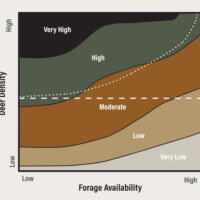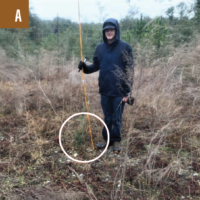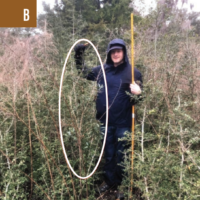 Purdue University - Extension - Forestry and Natural Resources
Purdue University - Extension - Forestry and Natural Resources
Got Nature? Blog
Purdue Extension: We invite you to read our 2024 Annual Impact Report to learn about some of the significant activities that Purdue Extension has led during this past year. We feature some of our most well-known programs, such as Master Gardener, as well as such up-and-coming ventures as Purdue on the Farm. In every story, what you discover and see in action is Extension’s profound commitment to providing diverse opportunities and ongoing support to all Indiana residents and to contributing to our state’s continued growth and stability.
 Check out the highlights for the Community Development and the Facilitative Leadership Workshop, along with other Purdue Extension programs:
Check out the highlights for the Community Development and the Facilitative Leadership Workshop, along with other Purdue Extension programs:
- Community Development, part of the Workforce Development program, sharing Digital Ready Business
- A Unique Learning Lab: Purdue Extension Facilitative Leadership Workshop
- 4-H Youth Development, Discovery Challenge program with students practicing essential communication skills and building career options
- Purdue Extension’s food as Medicine program, a prescription for better health.
- Purdue on the Farm, links growers and researchers.
- Cultivating Local Leaders
Resources:
Nature of Teaching, Purdue College of Agriculture
Community Development, Purdue Extension
Purdue Extension
Family Programs, Purdue Extension – Health and Human Sciences
Taking Action to Address Substance Use in Communities (TASC), Purdue Extension
Diversified Farming and Food Systems, Purdue Extension
Woodland Stewardship for Landowners, Playlist, Purdue Extension – Forestry and Natural Resources YouTube channel
A Woodland Management Moment, FNR – Ext Playlist
Hardwood Ecosystem Experiment – Wildlife Responses to Timber Harvesting, The Education Store, Purdue Extension resource center
Forest Improvement Handbook, The Education Store
Community Planning, FNR -Ext Playlist
Dan Walker, Community Development regional Educator
Purdue Forestry and Natural Resources/Illinois-Indiana Sea Grant/Purdue Extension
Kara Salazar, Assistant Program Leader for Community Development and Sustainable Communities Extension Specialist
Purdue Forestry and Natural Resources/Illinois-Indiana Sea Grant/Purdue Extension
The Hardwood Tree Improvement and Regeneration Center (HTIRC) was conceived in 1998 to address a perceived void in hardwood tree improvement research in the Central Hardwood Forest Region (CHFR) and is committed to enhancing the productivity and quality of CHFR trees and forests for the economic and environmental benefits they provide. Scientists at the HTIRC are using conventional tree improvement breeding as well as molecular and genetic technologies to improve the wood quality, growth characteristics, and insect and disease resistance of trees like black walnut, black cherry, red and white oaks, butternut and American chestnut. Research in tree breeding, tree nursery practices, tree plantation establishment and management, and Central Hardwoods silvicultural systems is aimed at increasing the regeneration success rate for high-quality hardwood trees and forests.
In this Fall 2024 HTIRC Newsletter you will find current research happenings that include:
- Butternut Workshop Highlights North American Efforts to Conserve Species – Butternut, a close relative of black walnut, is a declining and in many locations an endangered tree due in part to a fungal disease called butternut canker. Researchers are examining both the tree and the disease to develop strategies for conservation and restoration of the species.
- Olivia Bigham Presents Sassafras Wilt Study Results on National Webinar Series – Olivia Bigham, a PhD student in the Ginzel Lab at Purdue University recently presented on Sassafras Wilt in Indiana on the Emerald Ash Borer (EAB) University webinar series, a national webinar series highlighting forest insect, disease, and health research and extension.
- U.S. Forest Service Presents Tree Improvement 101 Webinar Series – A webinar series covering some core considerations for tree improvement, plus additional webinars on specific topics like black walnut seed orchard management and best practices for seed handling, is available from the U.S. Forest Service Reforestation, Nurseries and Genetic Resources (RNGR) program.
- 2024 HTIRC Seed Harvest Summary is Available – Every year HTIRC staff and students harvest hundreds of pounds of seed to support forestry researchers and nursery stakeholders, especially the Indiana Division of Forestry’s Vallonia State Nursery. Starting this year, the HTIRC also began supplying seed from select seed trees to Tree Pro for private distribution.
- Digital Forestry Can Help Mitigate, Prevent Wildfires – Digital Forestry offers a variety of tools and technologies to address resource management challenges. One of the greatest challenges currently is catastrophic wildfires threating communities and natural resources around the world. Learn how researchers at Purdue University’s Institute for Digital Forestry are leveraging technology to get more complete and accurate measurements of forests to assist with management of wildfires.
- Morgan Furze, New Tree Physiology Lab Highlighted in Recent Article – The tree physiology research of Dr. Morgan Furze and several other collaborating HTIRC scientists was highlighted in a recent article. “We’re interested in how trees store and move carbohydrates throughout their bodies and how that impacts their ability to survive and thrive in their environments,” Furze said.
View the full Fall 2024 HTIRC Newsletter and learn more about the impact and awards received along with more current research articles.
Resources:
HTIRC 2023 Annual Report
Hardwood Tree Improvement & Regeneration Center (HTIRC)
Tropical Hardwood Tree Improvement & Regeneration Center (tropHTIRC)
Partners, Purdue Forestry & Natural Resources
An Introduction to Trees of Indiana, The Education Store, Purdue Extension resource center
Native Trees of the Midwest, The Education Store
Shrubs and Woody Vines of Indiana and the Midwest, The Education Store
ID That Tree, Playlist, Subscribe to Purdue Extension – Forestry and Natural Resources YouTube Channel
A Woodland Management Moment, Playlist, Purdue Extension – FNR YouTube Channel
Investing in Indiana Woodlands, The Education Store
Forest Improvement Handbook, The Education Store
Finding help from a professional forester, Indiana Forestry & Woodland Owners Association
District Foresters for 10 plus acres, Indiana Department of Natural Resources
Wood Products, FNR Concentration
Hardwood Tree Improvement Regeneration Center (HTIRC)
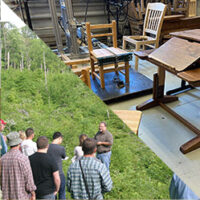 Purdue Extension’s annual report showcases the accomplishments, outcomes and activities that highlight the impact of Purdue Extension across Indiana. Extension specialists and educators provide educational programs and research-based knowledge to help families, individuals, and communities prosper and thrive.
Purdue Extension’s annual report showcases the accomplishments, outcomes and activities that highlight the impact of Purdue Extension across Indiana. Extension specialists and educators provide educational programs and research-based knowledge to help families, individuals, and communities prosper and thrive.
The Purdue Extension – Forestry and Natural Resources specialists featured:
Private Woodland Owners Make Decisions and Take Actions to Improve Acreage Value – project specialist include Lenny Farlee, Ron Rathfon, Don Carlson, and Jarred Brooke, along with county extension educators Dave Osborne, and Phil Woolery. Indiana has 20% forest lands, most privately owned. Forests are important habitats for wildlife and provide environmental and social benefits. Purdue Extension offers Forest Management for the Private Woodland Owner, in-person and virtually. The in-person program has eight 2.75-hour evening sessions and two Saturday three-hour field day tours. Purdue Extension and local forestry and natural resource professionals provide presentations and direct activities. Participants receive a tree measuring stick and a flash drive containing more than 100 publications and resources.
Participant forest management knowledge improved after the program. More than 90% found it useful for making decisions, and 80% plan to take actions in the next year. A participant said, “This course provided exactly the information I needed to understand the DNR forester’s report on my classified forest and to act on it. It will also help form a land management plan of my own (beyond what the forester provided), find programs to help manage and expand the forest, and earn a little money from the property in future years.”
Furniture Production Addresses Workforce Development and Rebuilds Lives in Indiana – project specialist include Dr. Eva Haviarova and Dr. Henry Quesada. Most U.S. school furniture is made overseas and from nonrenewable materials (steel, plastic, and composite). Increasingly, the product sustainability, the circular economy, and the benefits of natural materials are being shown to be important in learning environments.
To create a new market for low-value hardwoods, urban woods, and plantation resources by designing and producing innovative products, including wooden school furniture, Purdue’s Wood Research Lab has tested all strength and environmental attributes. At the same time, Purdue Extension is focusing on workforce development for Indiana’s wood products industry. An approach is to provide potential employment and entrepreneurial opportunities to residents with troubled pasts, underprivileged workers, and those needing a second chance in life by partnering with Purposeful Design, the Forest Service, Indiana Hardwood Lumbermen’s Association, Urban Forest Products and other industry players to train workers in furniture production and qualify for future work.
To view full report visit: Purdue Extension Showcase.
To learn more about Purdue Extension visit: About Us.
For all Purdue Extension – Forestry and Natural Resources publications, videos, webinars and initiatives view: Purdue Extension – Forestry and Natural Resources.
Resources:
A Woodland Management Moment, Playlist, Purdue Extension – Forestry and Natural Resources Youtube Channel
Invasive Species, Playlist
Woodland Stewardship for Landowners, Playlist
Invasive Plant Species Identification, Video
Invasive plants: impact on environment and people, The Education Store, Purdue Extension resource center
Investing in Indiana Woodlands, The Education Store
Woodland Invaders, Got Nature? Blog
District Forester, Indiana DNR Division of Forestry, for over 10 acres of woodlands
Directory of Professional Foresters, Indiana Forestry & Woodland Owners Association (IFWOA)
Indiana Woodland Steward E-newsletters, Eleven Member Organization
Conservation Tree Planting: Steps to Success, Purdue Extension – FNR Youtube Channel
Forest Improvement Handbook, The Education Store
Joint Design Manual for Furniture Frames Constructed of Plywood and Oriented Strand Board, The Education Store
The Shrinking and Swelling of Wood and Its Effect on Furniture, The Education Store
Performance Test Method for Intensive Use Chairs – FNEW 83-269: A Description of the Test Method with Drawings, The Education Store
How Baby Bear’s Chair Was Made, The Education Store
Diana Evans, Extension & Web Communications Specialist
Purdue University Department of Forestry and Natural Resources
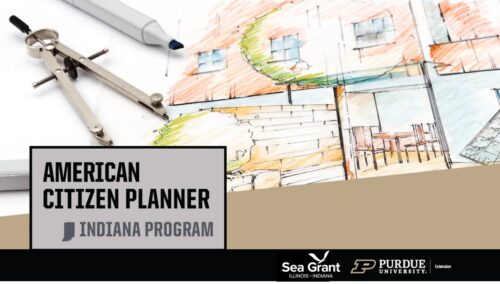 Agricultural & Natural Resources (ANR) Newsletter: This fall marks the conclusion of the fourth consecutive year of the American Citizen Planner – Indiana program. Launched during the pandemic in 2020, the program has successfully been offered statewide twice a year and has trained more than 250 community leaders. Participants come from diverse backgrounds, such as elected officials, professional planners, members of plan commissions, boards of zoning appeals, surveyors, engineers, and engaged citizens interested in local planning issues.
Agricultural & Natural Resources (ANR) Newsletter: This fall marks the conclusion of the fourth consecutive year of the American Citizen Planner – Indiana program. Launched during the pandemic in 2020, the program has successfully been offered statewide twice a year and has trained more than 250 community leaders. Participants come from diverse backgrounds, such as elected officials, professional planners, members of plan commissions, boards of zoning appeals, surveyors, engineers, and engaged citizens interested in local planning issues.
Tailored for Indiana’s planning statutes by the Purdue Land Use Team, the program has evolved to include new modules on Environmental Planning and Community Engagement, Enhancing Equity in Planning, and features invited guest speakers, alongside 28 online content modules. The core curriculum covers a wide range of topics essential for planning including ethics, decision making, a wide range of comprehensive planning and zoning topics, and engaging the public in the planning process. Registration for the 16-week virtual program opens each February and July, with Purdue Extension educators meeting with participants online four times throughout the course to facilitate discussions and interactive scenarios.
Feedback from participants underscores the program’s positive impact on their communities. A recent long-term follow-up survey revealed that many have utilized their newfound knowledge to update codes and ordinances, incorporate natural resource planning, and about 75% indicated they would share insights with their peers. One participant noted, “As a member of the town council in a community of about 230, this course has greatly enhanced my understanding of the planning process in our county. I feel much better equipped to evaluate zoning requests and look forward to leveraging planning to further develop our community!” Those who complete all course requirements are eligible to take the comprehensive exam and earn a course certificate.
The American Citizen Planner – Indiana program is available in your community. Follow Extension’s social media for registration updates and reach out to your local ANR educator to request an in-person workshop.
Resources:
Implementation Examples of Smart Growth Strategies in Indiana, The Education Store, Purdue Extension’s resource center
Conservation Through Community Leadership, The Education Store
Climate Change and Sustainable Development, The Education Store
Climate Change: Are you preparing for it?, The Education Store
Enhancing the Value of Public Spaces: Creating Healthy Communities, The Education Store
One Water Approach to Water Resources Management, The Education Store
Community Soundscape Planning Guide: Controlling Noise & Protecting Natural & Cultural Sonic Spaces, The Education Store
Agricultural Best Management Practices, The Education Store
Urban Best Management & Low Impact Development Practices, The Education Store
Rainscaping Education Program, Purdue Extension
Conservation Through Community Leadership, Sustainable Communities Extension Program (SCEP)
Community Planning Playlist, Purdue Extension-Forestry & Natural Resources (FNR) YouTube Channel
Rainscaping and Rain Gardens, Purdue Extension YouTube Channel
Conservation through Community Leadership, Purdue Extension You Tube Channel
Enhancing the Value of Public Spaces Program, Purdue Extension YouTube Channel
Tipping Point Planner, Purdue Agriculture YouTube Channel
Indiana Creek Watershed Project – Keys to Success, Partnerships and People, Purdue Extension You Tube Channel
Subscribe to Purdue Extension – Forestry and Natural Resources YouTube Channel
Dan Walker, Community Development regional Educator
Purdue Forestry and Natural Resources/Illinois-Indiana Sea Grant/Purdue Extension
Kara Salazar, Assistant Program Leader for Community Development and Sustainable Communities Extension Specialist
Purdue Forestry and Natural Resources/Illinois-Indiana Sea Grant/Purdue Extension
Quality of life encompasses individuals’ overall well-being, goals, expectations, standards, and concerns. Various factors shape a person’s perception of quality of life, such as physical and mental health, economic stability, social connections, education, and the environment. Access to healthcare, education, employment opportunities, and recreational facilities significantly influences a person’s ability to meet their needs and achieve their goals (World Health Organization, 2012).
Discover the power of quality of place and placemaking through this new publication by Kara Salazar, who is the Assistant Program Leader for Community Development for Purdue Extension along with being the Sustainable Communities Extension Specialist for Illinois-Indiana Sea Grant. Placemaking is the process of planning, designing, and managing public spaces to enhance quality of life and foster community. Effective placemaking, whether through tactical interventions like pop-up parks or strategic projects that reshape entire neighborhoods, revitalizes communities. By involving residents in the process, we create vibrant spaces that reflect local culture and values. These efforts not only improve quality of life but also attract investment, support local businesses, and promote sustainability.
To receive the free download, visit the Purdue Extension’s resource center: The Education Store – Quality of Place and Community Development.
Resources:
Implementation Examples of Smart Growth Strategies in Indiana, The Education Store, Purdue Extension’s resource center
Community Development, Purdue Extension
Enhancing the Value of Public Spaces Program Video, Purdue Extension
Enhancing the Value of Public Spaces: Creating Healthy Communities, The Education Store – Purdue Extension’s resource center
Enhancing the Value of Public Spaces Curriculum, The Education Store
Sustainable Communities Extension Program Website, Purdue Extension
Conservation Through Community Leadership, The Education Store
One Water Approach to Water Resources Management, The Education Store
Rainscaping Education Program, Purdue Extension
Indiana Creek Watershed Project – Keys to Success, Partnerships and People, Video, Purdue Extension You Tube Channel
Subscribe to Purdue Extension – Forestry and Natural Resources YouTube Channel
Kara Salazar, Sustainable Communities Extension Specialist
Purdue University Department of Forestry and Natural Resources
Deer are an important part of Indiana woodlands and represent a true conservation success story. Many Hoosiers spent time in the woods pursuing deer during hunting season or marveling at them during walks in their woodlands. But as recently as the 1930s deer were absent from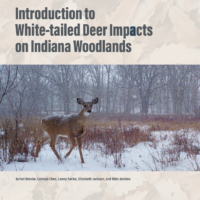 Indiana woodlands. Restocking efforts led by the Indiana Department of Natural Resources helped reestablish deer populations across the state. However, deer populations have rebounded beyond what the land can support in many areas, leading to issues like crop damage, deer-vehicle collisions, and damage to woodlands.
Indiana woodlands. Restocking efforts led by the Indiana Department of Natural Resources helped reestablish deer populations across the state. However, deer populations have rebounded beyond what the land can support in many areas, leading to issues like crop damage, deer-vehicle collisions, and damage to woodlands.
Deer overabundance can pose a threat to the future health of many Indiana woodlands. Deer are considered a “keystone” species, which means their feeding habits (browsing) can shape our woodlands’ look and their plant and wildlife communities. This publication will outline some of the impacts deer can have on Indiana woodlands and what signs and symptoms to look for in your woods.
Learn more about the amount of impact in this new publication:
Low Impact: When deer have little impact on your woodlands, you often see a high diversity of plants. An abundance of preferred species like trillium (picture) can also be a sign of low deer impact.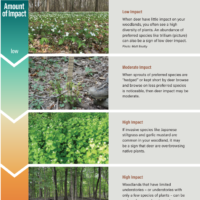
Moderate Impact: When sprouts of preferred species are “hedged” or kept short by deer browse and browse on less preferred species is noticeable, then deer impact may be moderate.
High Impact: If invasive species like Japanese stiltgrass and garlic mustard are common in your woodland, it may be a sign that deer are overbrowsing native plants.
High Impact: If invasive species like Japanese stiltgrass and garlic mustard are common in your woodland, it may be a sign that deer are overbrowsing native plants.
Very High Impact: Browse lines indicate a severe deer problem and appear when deer browse all plants within their reach (<6 feet).
You can read this full publication for free at Introduction to White-tailed Deer Impacts on Indiana Woodlands.
View the Deer Impact Toolbox for more resources and videos.
Resources:
Purdue Extension Pond and Wildlife Management
Introduction to White-tailed Deer Impacts on Indiana Woodlands
Understanding White-tailed Deer and Their Impact on Indiana Woodlands, The Education Store
Monitoring White-tailed Deer and Their Impact on Indiana Woodlands, The Education Store
Managing White-tailed Deer Impacts on Indiana Woodlands, The Education Store
Ask an Expert: Wildlife Food Plots, video, Purdue Extension – FNR YouTube Channel
How to Build a Plastic Mesh Deer Exclusion Fence, The Education Store
Managing Your Woods for White-Tailed Deer, The Education Store
Bovine Tuberculosis in Wild White-tailed Deer, The Education Store
Handling Harvested Game: Episode 1, Field Dressing, video, Purdue Extension – FNR YouTube Channel
Deer Harvest Data Collection, Got Nature? Blog, Purdue Extension – FNR
How to Score Your White-tailed Deer, video, The Education Store, Purdue Extension Resource Center
White-Tailed Deer Post Harvest Collection, video, The Education Store
Age Determination in White-tailed Deer, video, The Education Store
Handling Harvested Deer Ask an Expert? video, Purdue Extension – FNR YouTube Channel
Subscribe to Purdue Extension-Forestry & Natural Resources YouTube Channel, Wildlife Playlist
Jarred Brooke, Wildlife Extension Specialist
Purdue Department of Forestry and Natural Resources
Deer are an essential part of our ecosystems, but the phenomenon of too many deer should be of concern to forest landowners and the public in general. Deer are a “keystone” species, meaning their browsing can impact forest and wildlife communities. It is clear that when deer become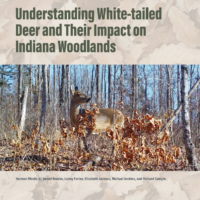 overabundant, their impact on the environment can be problematic. But by understanding the impacts deer have on our woodlands, their food preferences, and how to assess and evaluate impacts in your woodlands, we can begin to address the problems caused by overabundant deer.
overabundant, their impact on the environment can be problematic. But by understanding the impacts deer have on our woodlands, their food preferences, and how to assess and evaluate impacts in your woodlands, we can begin to address the problems caused by overabundant deer.
Learn more about the research and how it can help you and your land:
- Carrying Capacity
- Too Many Deer or Not Enough Food: Managing the Foodscape
- Monitoring Deer and Forest Vegetation
- Food Preferences
- Deer Impact Assessment
- More Resources
To receive the free download and recipe visit the Purdue Extension’s resource center: The Education Store – Understanding White-tailed Deer and Their Impact on Indiana Woodlands.
View the Deer Impact Toolbox for more resources and videos.
Resources:
Purdue Extension Pond and Wildlife Management
Introduction to White-tailed Deer Impacts on Indiana Woodlands
Understanding White-tailed Deer and Their Impact on Indiana Woodlands, The Education Store
Monitoring White-tailed Deer and Their Impact on Indiana Woodlands, The Education Store
Managing White-tailed Deer Impacts on Indiana Woodlands, The Education Store
Ask an Expert: Wildlife Food Plots, video, Purdue Extension – FNR YouTube Channel
How to Build a Plastic Mesh Deer Exclusion Fence, The Education Store
Managing Your Woods for White-Tailed Deer, The Education Store
Bovine Tuberculosis in Wild White-tailed Deer, The Education Store
Handling Harvested Game: Episode 1, Field Dressing, video, Purdue Extension – FNR YouTube Channel
Deer Harvest Data Collection, Got Nature? Blog, Purdue Extension – FNR
How to Score Your White-tailed Deer, video, The Education Store, Purdue Extension Resource Center
White-Tailed Deer Post Harvest Collection, video, The Education Store
Age Determination in White-tailed Deer, video, The Education Store
Handling Harvested Deer Ask an Expert? video, Purdue Extension – FNR YouTube Channel
Subscribe to Purdue Extension-Forestry & Natural Resources YouTube Channel, Wildlife Playlist
Jarred Brooke, Wildlife Extension Specialist
Purdue Department of Forestry and Natural Resources
Wherever deer exist, they will be impacting the ecosystem through browsing. But at what level is that impact considered harmful? Many ecologists consider deer impact harmful when deer begin to reduce plant diversity in a woodland through browsing. knowing the exact number of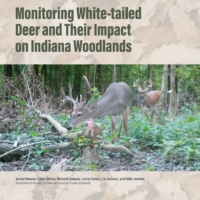 deer on a property is difficult to measure and unnecessary. There are relatively easy ways to estimate the number of deer on a property or track trends in population sizes over time. This publication is written to help woodland owners better understand how to monitor deer and their impact.
deer on a property is difficult to measure and unnecessary. There are relatively easy ways to estimate the number of deer on a property or track trends in population sizes over time. This publication is written to help woodland owners better understand how to monitor deer and their impact.
Monitoring deer impact is done by surveying what deer eat in a forest and how intensively they browse those species. Deer are browsers rather than grazers (like bison and cattle), preferring to eat forbs (broadleaf herbaceous plants), vines, shrubs, and trees rather than grasses. Deer also select specific parts of the plants (e.g., leaves, twigs, and young tender growth).
Monitoring Deer Impact Methods: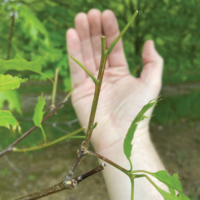
- Browse Surveys
- Indicator Plants
- Assessing Vegetation Impacts from Deer
- Ten-Tallest Method
- Twig-Aging
- Oak Sentinel
- Stump Sprouts
To receive the free download visit the Purdue Extension’s resource center: The Education Store – Monitoring White-tailed Deer and Their Impact on Indiana Woodlands.
Resources:
Purdue Extension Pond and Wildlife Management
Introduction to White-tailed Deer Impacts on Indiana Woodlands
Understanding White-tailed Deer and Their Impact on Indiana Woodlands, The Education Store
Monitoring White-tailed Deer and Their Impact on Indiana Woodlands, The Education Store
Managing White-tailed Deer Impacts on Indiana Woodlands, The Education Store
Ask an Expert: Wildlife Food Plots, video, Purdue Extension – FNR YouTube Channel
How to Build a Plastic Mesh Deer Exclusion Fence, The Education Store
Managing Your Woods for White-Tailed Deer, The Education Store
Bovine Tuberculosis in Wild White-tailed Deer, The Education Store
Handling Harvested Game: Episode 1, Field Dressing, video, Purdue Extension – FNR YouTube Channel
Deer Harvest Data Collection, Got Nature? Blog, Purdue Extension – FNR
How to Score Your White-tailed Deer, video, The Education Store, Purdue Extension Resource Center
White-Tailed Deer Post Harvest Collection, video, The Education Store
Age Determination in White-tailed Deer, video, The Education Store
Handling Harvested Deer Ask an Expert? video, Purdue Extension – FNR YouTube Channel
Subscribe to Purdue Extension-Forestry & Natural Resources YouTube Channel, Wildlife Playlist
Jarred Brooke, Wildlife Extension Specialist
Purdue Department of Forestry and Natural Resources
White-tailed deer are an integral piece of Indiana’s forest ecosystems. When in balance with the ecosystem, deer can enhance the health of the forest. This publication highlights the various tools available to woodland owners for mitigating the impacts of deer on their regenerating trees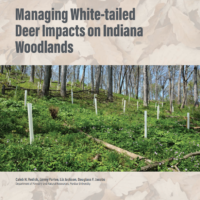 and is based on a compilation of research on the relative effectiveness of various deer browse control methods.
and is based on a compilation of research on the relative effectiveness of various deer browse control methods.
What control methods are available to help with forest regeneration? You will find the answer to this question and more, along with what deer population control means for forest landowners in this publication.
Check out the publications for the “Browse Control Methods for Forest Regeneration and Their Effectiveness” table which includes these control methods: Fencing; Population Control; Tree Shelters; Cages; Companion Plants; Repellents; Timber Harvests; Slash; and Fertilizer.
To receive the free download and recipe visit the Purdue Extension’s resource center: The Education Store – Managing White-tailed Deer Impacts on Indiana Woodlands.
Resources:
Purdue Extension Pond and Wildlife Management
Introduction to White-tailed Deer Impacts on Indiana Woodlands
Understanding White-tailed Deer and Their Impact on Indiana Woodlands, The Education Store
Monitoring White-tailed Deer and Their Impact on Indiana Woodlands, The Education Store
Managing White-tailed Deer Impacts on Indiana Woodlands, The Education Store
Ask an Expert: Wildlife Food Plots, video, Purdue Extension – FNR YouTube Channel
How to Build a Plastic Mesh Deer Exclusion Fence, The Education Store
Managing Your Woods for White-Tailed Deer, The Education Store
Bovine Tuberculosis in Wild White-tailed Deer, The Education Store
Handling Harvested Game: Episode 1, Field Dressing, video, Purdue Extension – FNR YouTube Channel
Deer Harvest Data Collection, Got Nature? Blog, Purdue Extension – FNR
How to Score Your White-tailed Deer, video, The Education Store, Purdue Extension Resource Center
White-Tailed Deer Post Harvest Collection, video, The Education Store
Age Determination in White-tailed Deer, video, The Education Store
Handling Harvested Deer Ask an Expert? video, Purdue Extension – FNR YouTube Channel
Subscribe to Purdue Extension-Forestry & Natural Resources YouTube Channel, Wildlife Playlist
Jarred Brooke, Wildlife Extension Specialist
Purdue Department of Forestry and Natural Resources
White-tailed deer are an important part of our Hoosier natural areas and a true conservation success story. Once extirpated from Indiana, deer now thrive in all 92 counties.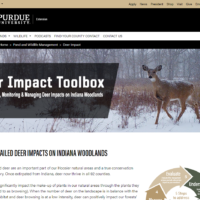
Deer can significantly impact the make-up of plants in our natural areas through the plants they eat (referred to as browsing). When the number of deer on the landscape is in balance with the available habitat and deer browsing is at a low intensity, deer can positively impact our forests’ plant diversity. When deer are overabundant, their browsing can impact forests in a variety of negative ways.
5 Steps to address deer impacts to Indiana Woodlands:
Understanding
Understand how deer impact Indiana’s forest ecosystems.
Identify
Identify signs and symptoms of deer impact in your woodland.
Monitor
Monitor how deer are impacting your woodland over time.
Manage
Decide how to manage deer and their impact on your woodland.
Evaluate
Evaluate if the management actions you took reduced deer impact on your woodland.
Check out the new Deer Impact Toolbox website for publications and more details to discover the steps landowners and land managers can take to understand, monitoring, and manage deer impacts to Indiana’s forests.
Don’t miss the videos: Monitoring Deer Impacts on Indiana Forests: Ten-Tallest Method and Monitoring Deer Impacts on Indiana Forests: Accessing Vegetation Impacts for Deer (AVID) Plots.
Check out the College of Agriculture news article to learn more: Deer Impact Toolbox provides guidance for Indiana forest landowners and managers.
Resources:
Purdue Extension Pond and Wildlife Management
Understanding White-tailed Deer and Their Impact on Indiana Woodlands, The Education Store
Monitoring White-tailed Deer and Their Impact on Indiana Woodlands, The Education Store
Managing White-tailed Deer Impacts on Indiana Woodlands, The Education Store
Ask an Expert: Wildlife Food Plots, video, Purdue Extension – FNR YouTube Channel
How to Build a Plastic Mesh Deer Exclusion Fence, The Education Store
Managing Your Woods for White-Tailed Deer, The Education Store
Bovine Tuberculosis in Wild White-tailed Deer, The Education Store
Handling Harvested Game: Episode 1, Field Dressing, video, Purdue Extension – FNR YouTube Channel
Deer Harvest Data Collection, Got Nature? Blog, Purdue Extension – FNR
How to Score Your White-tailed Deer, video, The Education Store, Purdue Extension Resource Center
White-Tailed Deer Post Harvest Collection, video, The Education Store
Age Determination in White-tailed Deer, video, The Education Store
Handling Harvested Deer Ask an Expert? video, Purdue Extension – FNR YouTube Channel
Subscribe to Purdue Extension-Forestry & Natural Resources YouTube Channel, Wildlife Playlist
Jarred Brooke, Wildlife Extension Specialist
Purdue Department of Forestry and Natural Resources
Recent Posts
- Purdue Extension 2024 Impact Report
Posted: January 16, 2025 in Forestry, Land Use, Plants, Publication, Wildlife, Woodlands - Hardwood Tree Improvement Regeneration Center (HTIRC) Shares Fall Newsletter, Research and Outreach
Posted: December 13, 2024 in Forestry, Land Use, Natural Resource Planning, Woodlands - Purdue Extension’s Showcase, Impacting Indiana
Posted: November 8, 2024 in Community Development, Forestry, Forests and Street Trees, Gardening, Land Use, Natural Resource Planning, Timber Marketing, Urban Forestry, Wildlife, Wood Products/Manufacturing, Woodlands - American Citizen Planner – Indiana Program Celebrating 4 Years of Impact
Posted: October 16, 2024 in Community Development, Land Use - Publication – Quality of Place and Community Development
Posted: July 18, 2024 in Community Development, Land Use, Publication, Urban Forestry - Publication – Introduction to White-tailed Deer Impacts on Indiana Woodlands
Posted: April 28, 2024 in Forestry, Land Use, Plants, Publication, Wildlife, Woodlands - Publication – Understanding White-tailed Deer and Their Impact on Indiana Woodlands
Posted: in Forestry, Land Use, Plants, Publication, Wildlife, Woodlands - Publication – Monitoring White-tailed Deer and Their Impact on Indiana Woodlands
Posted: in Forestry, Land Use, Plants, Publication, Wildlife, Woodlands - Publication – Managing White-tailed Deer Impacts on Indiana Woodlands
Posted: in Forestry, Land Use, Plants, Publication, Wildlife, Woodlands - New Deer Impact Toolbox
Posted: April 7, 2024 in Forestry, Land Use, Plants, Publication, Safety, Wildlife, Woodlands
Archives
Categories
- Alert
- Aquaculture/Fish
- Aquatic/Aquaculture Resources
- Ask the Expert
- Christmas Trees
- Community Development
- Disease
- Drought
- Forestry
- Forests and Street Trees
- Gardening
- Got Nature for Kids
- Great Lakes
- How To
- Invasive Animal Species
- Invasive Insects
- Invasive Plant Species
- Land Use
- Natural Resource Planning
- Nature of Teaching
- Plants
- Podcasts
- Ponds
- Publication
- Safety
- Spiders
- Timber Marketing
- Uncategorized
- Urban Forestry
- Webinar
- Wildlife
- Wood Products/Manufacturing
- Woodland Management Moment
- Woodlands


